Sinai place names
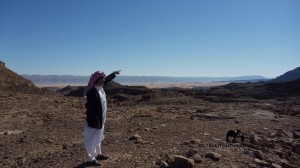 The Sinai might look like a big emptiness: a sort of unpeopled desert that wouldn’t need names. But it’s exceptionally rich in place names; richer than many of the world’s most heavily settled regions. The Bedouin developed a rich topographical vocabulary and they joke every part of the Sinai – every rock – has a name. Place names weren’t just ornamentation. In the absence of maps, the Bedouin had to represent the land minutely in language, attaching different names to as many places as possible, so they could navigate precisely, explain it to others, find what they needed etc. Most place names in Sinai were given after the Bedouin settled, although some have much earlier roots. The most common types of names are sketched out below:
The Sinai might look like a big emptiness: a sort of unpeopled desert that wouldn’t need names. But it’s exceptionally rich in place names; richer than many of the world’s most heavily settled regions. The Bedouin developed a rich topographical vocabulary and they joke every part of the Sinai – every rock – has a name. Place names weren’t just ornamentation. In the absence of maps, the Bedouin had to represent the land minutely in language, attaching different names to as many places as possible, so they could navigate precisely, explain it to others, find what they needed etc. Most place names in Sinai were given after the Bedouin settled, although some have much earlier roots. The most common types of names are sketched out below:
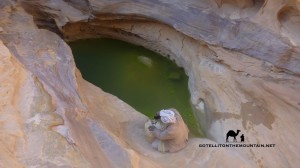 WATER – Water is gold in the desert and its presence was almost ALWAYS indicated in place names. The name would note the type of source, with the common ones being bir (well), ein (spring) and moiyet (pool). Where important, and often when it was dubious, water quality would be alluded to as well. Bir Melha means ‘The Salty Well’ and Moiyet Ramliya, ‘The Sandy Pool’, for example. Other water words to listen out for are galt and kharaza, both meaning a deep pool (the first fed by underground springs, the second by rain); shellal, meaning ‘waterfall’, and sed, meaning a block, or a dam, usually below a waterfall.
WATER – Water is gold in the desert and its presence was almost ALWAYS indicated in place names. The name would note the type of source, with the common ones being bir (well), ein (spring) and moiyet (pool). Where important, and often when it was dubious, water quality would be alluded to as well. Bir Melha means ‘The Salty Well’ and Moiyet Ramliya, ‘The Sandy Pool’, for example. Other water words to listen out for are galt and kharaza, both meaning a deep pool (the first fed by underground springs, the second by rain); shellal, meaning ‘waterfall’, and sed, meaning a block, or a dam, usually below a waterfall.
 USEFUL RESOURCES – Just like water was noted, some place names underlined the presence of useful resources. E.g. Wadi el Zatar – ‘Wadi of the Oregano’, Abu Habag – ‘The Place of Mint’, and Farsh Tuta– ‘Basin of the Mulberry Tree’.
USEFUL RESOURCES – Just like water was noted, some place names underlined the presence of useful resources. E.g. Wadi el Zatar – ‘Wadi of the Oregano’, Abu Habag – ‘The Place of Mint’, and Farsh Tuta– ‘Basin of the Mulberry Tree’.
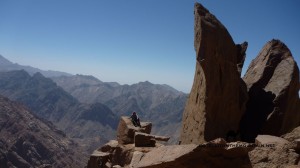 PHYSICAL FEATURES – Some names just say how a place looks. These could be instantly recognisable to anybody and were thus useful navigational landmarks. It might be the colour: Jebel el Ahmar is ‘The Red Mountain’ and Galt el Azraq is ‘The Blue Pool’, for example. Or simply the shape: zibb is Arabic slang for penis and the Sinai has a few peaks with its name; usually high, upstanding pinnacles. Masba Abu Garoon means ‘Place of the Horns’ and is the name of a place where two, sharp rocks stand up; like a pair of goat’s horns.
PHYSICAL FEATURES – Some names just say how a place looks. These could be instantly recognisable to anybody and were thus useful navigational landmarks. It might be the colour: Jebel el Ahmar is ‘The Red Mountain’ and Galt el Azraq is ‘The Blue Pool’, for example. Or simply the shape: zibb is Arabic slang for penis and the Sinai has a few peaks with its name; usually high, upstanding pinnacles. Masba Abu Garoon means ‘Place of the Horns’ and is the name of a place where two, sharp rocks stand up; like a pair of goat’s horns.
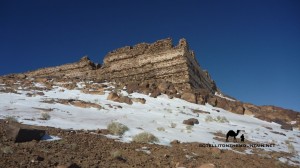 HISTORICAL NAMES – Some names nod to a special historical connection. Jebel Abbas Basha – ‘Mountain of the Pasha’ – is a peak that bears the name of an Ottoman Pasha who began building a palace on it as a sanatorium for his tuberculosis (only to die before it was finished). Bir Nasrani means ‘Well of the Christian’, supposedly after a Christian who excavated it. Wadi Hajjaj – or ‘Wadi of the Pilgrims’ – is a wadi that runs over the Sinai and was once the way pilgrims passed through en-route to St Katherine .
HISTORICAL NAMES – Some names nod to a special historical connection. Jebel Abbas Basha – ‘Mountain of the Pasha’ – is a peak that bears the name of an Ottoman Pasha who began building a palace on it as a sanatorium for his tuberculosis (only to die before it was finished). Bir Nasrani means ‘Well of the Christian’, supposedly after a Christian who excavated it. Wadi Hajjaj – or ‘Wadi of the Pilgrims’ – is a wadi that runs over the Sinai and was once the way pilgrims passed through en-route to St Katherine .
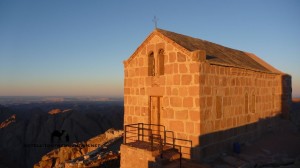 BIBLICAL LEGEND – The Sinai is steeped in legends of The Exodus; events of the Exodus are often recorded in Bedouin place names, not least as they testify to events holy in Islam too. Mount Sinai – as we know it – became Jebel Musa to the Bedouin; literally ‘The Mountain of Moses’. Below Jebel Musa is a huge plain called El Raha. This means ‘The Rest’in Arabic, as legend has it the Israelites camped here when Moses was getting the Ten Commandments. Hadabat el Tih means ‘Plateau of the Lost’ after the place it’s said the Israelites wandered 40 years. We know this today as the Wilderness of the Wanderings.
BIBLICAL LEGEND – The Sinai is steeped in legends of The Exodus; events of the Exodus are often recorded in Bedouin place names, not least as they testify to events holy in Islam too. Mount Sinai – as we know it – became Jebel Musa to the Bedouin; literally ‘The Mountain of Moses’. Below Jebel Musa is a huge plain called El Raha. This means ‘The Rest’in Arabic, as legend has it the Israelites camped here when Moses was getting the Ten Commandments. Hadabat el Tih means ‘Plateau of the Lost’ after the place it’s said the Israelites wandered 40 years. We know this today as the Wilderness of the Wanderings.
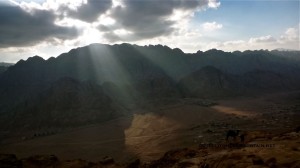 BEDOUIN LEGEND – Bedouin legends aren’t forgotten in the place names either. The Bedouin had a rich oral tradition and names like this added meaning and magic to the landscape. Climb Jebel Umm Shomer and you’ll find Hajar el Bint – ‘The Girl’s Rock’, where it was said a damsel with long, flowing hair lived, enchanting the Bedouin with her beautiful song. Jebel Banat – Mountain of the Girls – is named after two Bedouin sisters who it’s said ran away one day and jumped to their deaths from the top, rebelling against their father’s wishes to marry them to men they didn’t love.
BEDOUIN LEGEND – Bedouin legends aren’t forgotten in the place names either. The Bedouin had a rich oral tradition and names like this added meaning and magic to the landscape. Climb Jebel Umm Shomer and you’ll find Hajar el Bint – ‘The Girl’s Rock’, where it was said a damsel with long, flowing hair lived, enchanting the Bedouin with her beautiful song. Jebel Banat – Mountain of the Girls – is named after two Bedouin sisters who it’s said ran away one day and jumped to their deaths from the top, rebelling against their father’s wishes to marry them to men they didn’t love.
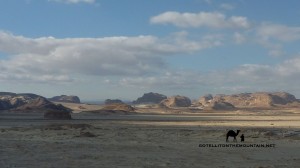 THE EARLY AGES – Some names aren’t actually Arabic. They go back to the early ages and were passed down from one group to the next, probably being corrupted along the way. Jebel Serbal might be one of these; some reckon it’s a pre-Arabic word derived from the early God Baal. As for the name Sinai, some say it comes from the Arabic word sinn, meaning ‘tooth’, after the triangular shape of the peninsula. Others suggest it’s derived from the name of another early God – a God of the moon – who was worshipped here.
THE EARLY AGES – Some names aren’t actually Arabic. They go back to the early ages and were passed down from one group to the next, probably being corrupted along the way. Jebel Serbal might be one of these; some reckon it’s a pre-Arabic word derived from the early God Baal. As for the name Sinai, some say it comes from the Arabic word sinn, meaning ‘tooth’, after the triangular shape of the peninsula. Others suggest it’s derived from the name of another early God – a God of the moon – who was worshipped here.